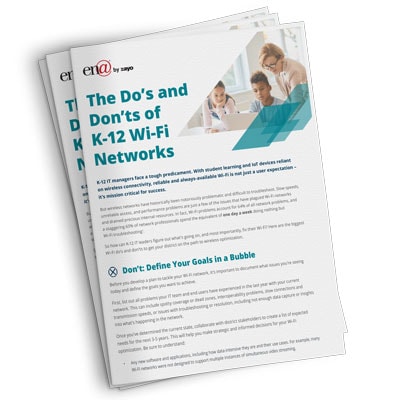K-12 IT managers face a tough predicament. With student learning and IoT devices reliant on wireless connectivity, reliable and always-available Wi-Fi is not just a user expectation – it's mission critical for success.
But wireless networks have historically been notoriously problematic and difficult to troubleshoot. Slow speeds, unreliable access, and performance problems are just a few of the issues that have plagued Wi-Fi networks and drained precious internal resources.
In fact, Wi-Fi problems account for 64% of all network problems, and a staggering 60% of network professionals spend the equivalent of one day a week doing nothing but Wi-Fi troubleshooting1.
So how can K-12 IT leaders figure out what’s going on, and most importantly, fix their Wi-Fi? Here are the biggest Wi-Fi do’s and don’ts to get your district on the path to wireless optimization.
Don’t: Define Your Goals in a Bubble
Before you develop a plan to tackle your Wi-Fi network, it’s important to document what issues you’re seeing today and define the goals you want to achieve.
First, list out all problems your IT team and end users have experienced in the last year with your current network. This can include spotty coverage or dead zones, interoperability problems, slow connections and transmission speeds, or issues with troubleshooting or resolution, including not enough data capture or insights into what’s happening in the network.
Once you’ve determined the current state, collaborate with district stakeholders to create a list of expected needs for the next 3-5 years. This will help you make strategic and informed decisions for your Wi-Fi optimization. Be sure to understand:
- Any new software and applications, including how data-intensive they are and their use cases. For example, many Wi-Fi networks were not designed to support multiple instances of simultaneous video streaming.
- Any new IoT devices or infrastructure, including smart printers and thermostats, security devices, etc.
- The district’s student device strategy – what devices do you use today? How do you anticipate that to grow?
- Any upcoming facility renovations or expansions that would require more access points, cabling, etc., and change a Wi-Fi network’s design
Do: Invest in a Full WLAN Assessment
Now that you’ve defined your goals, the next step is to collaborate with a provider to do a deep dive into your wireless system with a WLAN assessment. Share the goals, issues, and problem areas you defined from your planning stage with the vendor.
Your vendor will then run a series of comprehensive tests including wireless site/facility surveys, configuration assessments, application performance testing, and more, which will identify opportunities for performance optimization, coverage improvement, and capacity enhancement. They should also provide detailed insights into network best practices and standards being used, and identify what areas are causing problems.
Don’t: Skimp on the Network Design
With the latest advancements in Wi-Fi technology and automation, it can be easy to think you don’t need a professional or certified engineer to design your network after a WLAN assessment, but this is a critical mistake.
Bad network design directly leads to slow connections, spotty coverage, frustrated users, overworked IT teams, and ultimately, wasted time and money in the long run. For example, self-healing hardware cannot always be relied upon, and auto-selected channels may not suit your campus.
This is why it’s so important to assess your campus’s RF environment – problems can be related to density, the client, software on the device, DNS issues, DHCP problems, and/or configuration.
A good wireless engineer will be able to pinpoint where the problems lie and build a network from the ground up, including channel plan and power settings, that are designed and optimized for your community’s actual devices and usage.
Don’t: Assume New Equipment or Simply Adding APs Will Improve Your Network
Many communities invest large sums in upgrading to the latest technologies or hardware, only to find their service unimproved. This stems from the incorrect assumption that simply adding more or newer access points (APs) will automatically address the problem.
The truth is, in some cases adding APs can actually introduce interference issues. Networks need to be seen as a holistic system, and AP placement needs to be optimized for each environment.
This is why a top-to-bottom assessment and engineering expertise are required to address any problems. A good engineer will be able to design a network that yields better results from fewer devices.
Do: Consider AI and Automation in Your Network
It’s no secret, Wi-Fi troubleshooting and operations are difficult. In 52% of cases, it takes over an hour to isolate a Wi-Fi problem1. Not good.
But the game is changing – machine learning and AI-based technologies are helping IT teams spend less time on troubleshooting and more time on strategic priorities. Intelligent cloud-based Wi-Fi hardware can now leverage AI engines to help detect anomalies, remediate AP problems, identify the root cause of issues across IT domains, and help IT teams get answers in real-time.
Translation: your team enjoys streamlined operations, simplified troubleshooting, and boosted user experiences. Better connectivity, less stress, win-win.
Don't: Set It and Forget It
Just like humans, networks need regular and proactive check-ups to keep them in good health. A good wireless network should always be seen as a work in progress.
If your RF environment changes, you may need to redesign or reconfigure it, because some changes can hinder your network’s performance. To ensure peak performance, engineers must conduct periodic reviews focused on continuous optimization, ensuring your network is healthy and users are happy.
Do: Leverage All Available Funding Resources
K-12 budgets are tight, Wi-Fi expertise is scarce, and upgrades are expensive. Make sure your district is leveraging all available funding options for your wireless connectivity.
The FCC’s E-rate program enables K-12 districts and libraries to receive Wi-Fi funding under Category 2, either through Internal Connections or Managed Internal Broadband Services (MIBS). Click here to learn more about E-rate’s eligible services.
The Bottom Line
The quality of your Wi-Fi network’s performance and reliability ultimately comes down to two factors: the network design and the vendor you partner with.
Not every WLAN assessment or network design is created equal, making choosing the right partner even more critical. A bad vendor will cut corners on design and disengage when the sale is complete – leaving you puzzled when their new equipment doesn’t solve the original problem(s).
Additionally, wireless and wired networks are complex, requiring high level engineering expertise. If your district doesn’t have this in-house, partnering with a managed Wi-Fi provider is a great way to cost-effectively leverage wireless engineers for design, implementation, and ongoing management.
Sources: https://www.networkworld.com/article/3355237/why-wi-fi-needs-artificial-intelligence.html
Smarter Wi-Fi Starts Here
At ENA by Zayo, we have world-class wireless engineering talent ready to assess, diagnose, and fix your Wi-Fi issues, no matter how complex or challenging. Additionally, we have a range of hardware, services, and management options available that can be customized to meet your specific needs, no matter where you are in your Wi-Fi network journey.

